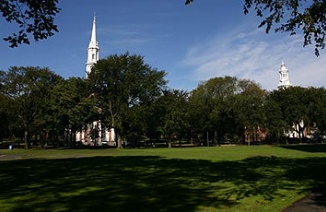|
2017年12月2日 | |
类别:生物类 真题 150201CN-P3
Title:Dinosaurs and Parental Care
From fossil evidence alone the question of whether or not dinosaurs cared for their young is very difficult to answer. Because behaviors are not preserved in the fossil record, we can only make inferences from indirect evidence. Parental care can be divided into two types of behavior: prehatching (building nests and incubating eggs—for example, sitting on top of them so as to warm the eggs and encourage hatching) and posthatching (feeding the young and guarding the nests). Most of our evidence comes from alleged dinosaur rookeries (places where nests are built). Several have been excavated in eastern Montana, where a large concentration of dinosaur nests was found at a place now called Egg Mountain. Most of these probably belonged to the hadrosaur Maiasaura. Preserved in these nests are the bones of baby dinosaurs. The finds at Egg Mountain and other sites around the world document that dinosaurs laid their eggs in nests.
The nests at Egg Mountain are reported to be equally spaced, separated by a space corresponding to the length of an adult Maiasaura. From this arrangement scientists have inferred that the nests were separated in this way to allow incubation in a tightly packed nesting colony. Although this interpretation is open to challenge, the discovery of Oviraplor adults on top of Oviraplor egg clutches (as determined by embryos in some eggs), is relatively powerful evidence that at least these dinosaurs incubated their nests.
...
文章题目 Solving an Arctic Mystery
重复年份 20160521 20141025
题材 人文社科
题型 判断 7+填空 6
文章大意 北极沉船。两条执行任务的船消失了,很多人试图找到它们,但都失败了,最后在 sonar 技术的支持下找到了。船上所有船员全部通过遇难的原因探究中发现,他们遗骸中很多都 lead 超标,研究发现 tin of food 及 inheritance 等因素均不是汽运,造成中毒的原因是 water needed for engine。研究结果跟 inuit 人的口头记录温和,证实了其可靠性。
类别:考古类 真题 150201CN-P2
Title:The Chaco Phenomenon
参考阅读:
A truly remarkable transformation in settlement patterns occurred in the San Juan basin in northwestern New Mexico in the late tenth and early eleventh centuries, with small household farmsteads giving way to aggregated communities centered on communal masonry buildings that are now called “great houses.” These structures are found throughout the basin but are concentrated in Chaco Canyon, where several examples contained hundreds of rooms and reached four stories in height. The largest great house is Pueblo Bonito, with over 600 rooms covering two acres. The entire episode of great house construction in Chaco, the Bonito phase (A.D. 900-1140), was obviously a time of immense cooperative effort. At least 200,000 wooden beams averaging 5 meters long and 20 centimeters in diameter were brought to the canyon from distances between 40 and 100 kilometers away to build a dozen great houses, signifying a huge labor investment and a complex production process. The bulk of construction took place in the eleventh century, but by A.D. 1140 it had ceased abruptly, after which there was a rapid decline in use of the great houses and apparent abandonment of the canyon in the thirteenth century.
...
类别:考古类 真题 141018CN-P3
Title:The Collapse of the Mays
The Mayan society of Central America (2000 B.C. – A.D. 1500), like other ancient states, was characterized by populations unprecedented both in their size and density. It was not just the number of people that lived in the Mayan city-states but also the relatively small area into which they were concentrated. To support such populations, societies developed various intensive agricultural methods, including large-scale irrigation and hill-slope terracing (the cutting of horizontal ridges into hillsides so they can be farmed). These were designed both to increase yields from a given area and to increase the absolute amount of land under cultivation. These strategies were in essence very successful: hey made it possible to feed larger populations than ever before and supported the growth of cities. But they also placed considerable strains on the environment and rendered it increasingly fragile and vulnerable to unexpected climatic events, and even to short-term fluctuations. Thus, the argument is that because of their size and ever more intensive agriculture, the Mayan and other ancient state societies were fundamentally unsustainable.
...

















